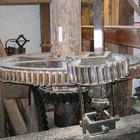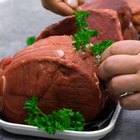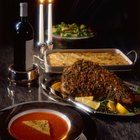
Long before the days when food processors and blenders were standard electric appliances in the kitchen, manual meat grinders made of heavy-duty steel were used for the laborious tasks of chopping and grinding. The Universal brand of meat grinders, manufactured in New Britain, Connecticut, from the mid-19th century through the 1980s, are now marketed by ownership that puts an emphasis on their use as gourmet food choppers. The No. 2 model, smallest of three available versions, grinds about 2 1/2 lbs. of meat or produce per minute under normal conditions, although your own pace of turning the handle determines the actual outcome.
Grasp the stem of the grinder with one hand just below the grinding chamber and above the brackets at the bottom of the implement. With the other hand, turn the oversized screw at the bottom counterclockwise to open up the space between the brackets.
Position the grinder's brackets around the upper and lower surfaces of an overhanging edge of your countertop or the edge of a table. Push the back of the bracket tight against the countertop or table and turn the bottom screw clockwise to tighten the bracket's hold.
Insert the large screw-shaped end of the auger-and-handle grinder part into the chamber of the meat grinder from the back side of the grinder which is positioned away from the counter or table top. Push the threaded tip of the auger through the hole in the center of the front side of the grinder.
Hold the auger-and-handle piece in place with one hand. With the other hand, slip the cog-wheel shaped disk onto the threaded end of the auger that is protruding through the front of the grinder.
Place the large wingnut piece of the grinder on the threaded auger-end and screw it clockwise until it is tightly holding the cogwheel-like disk firmly against the front of the grinder. Rotate the grinder handle two to three times and loosen the wingnut screw slightly, if necessary, for the entire auger-and-handle assembly to move freely.
Fill the grinding chamber loosely by placing chunks of meat into the wide funnel-shaped opening at the top of the grinder.
Set a plate or pan with low sides on the table, directly under the cogwheel at the front of the meat grinder to catch the ground meat as it drops from the front of the grinder.
Rotate the handle of the filled grinder clockwise. The auger assembly pushes the meat through the cogwheel, where it's broken down into uniform-size smaller pieces as it is pushed through the cogwheel.
Related Articles

Tools Used in Food Processing

How to Assemble a Food Mill

How to Cook With the Sunbeam Rotisserie

How to Fix a Stalled Second Hand on a ...

How to Disassemble Remington Shavers

How to Fix a Fanny-Pack Webbing Clip
How to Barbecue Prime Rib Bones

How to Remove the Batteries From Salter ...

The Manufacturing Process of a Watch

How to Make a Flour Mill Machine

How to Fold a Graco Stroller

Can I Cook Gyro Meat on a Rotisserie?

How to Replace the Battery in a ...

How to Make Homemade Propane Pig Cookers

How to Ground Pork

How to Smoke a Leg of Lamb Using an ...

How to Grate Beetroot

How to Cook a Roast Beef on a ...

How to Change the Battery in a Bulova ...

How to Build a Hop Harvesting Machine
References
Writer Bio
Denise Schoonhoven has worked in the fields of acoustics, biomedical products, electric cable heating and marketing communications. She studied at Newbold College and Middlesex Polytechnic in the UK, and Walla Walla University. A writer since 2008, Schoonhoven is a seasoned business traveler, solo tourist, gardener and home renovator.
Photo Credits
Jupiterimages/Comstock/Getty Images